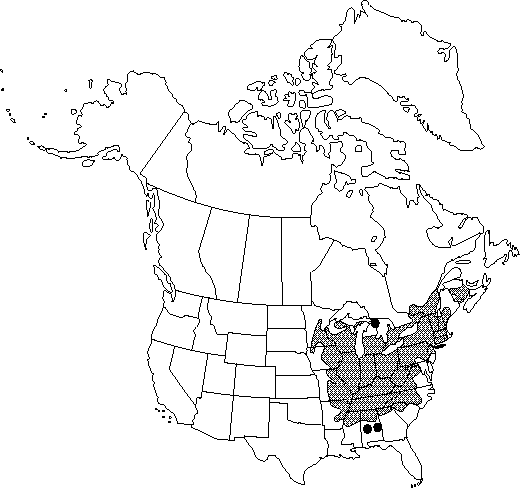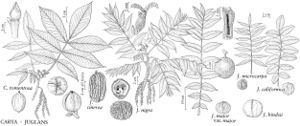Difference between revisions of "Juglans cinerea"
Syst. Nat. ed. 10, 1272. 1759.
FNA>Volume Importer |
RevisionBot (talk | contribs) m (Bot: Adding category Revised Since Print) |
||
| (8 intermediate revisions by 3 users not shown) | |||
| Line 16: | Line 16: | ||
}}{{Treatment/ID/Special_status | }}{{Treatment/ID/Special_status | ||
|code=F | |code=F | ||
| − | |label= | + | |label=Illustrated |
}} | }} | ||
|basionyms= | |basionyms= | ||
| Line 22: | Line 22: | ||
|name=Wallia cinerea | |name=Wallia cinerea | ||
|authority=(Linnaeus) Alefeld | |authority=(Linnaeus) Alefeld | ||
| + | |rank=species | ||
}} | }} | ||
|hierarchy=Juglandaceae;Juglans;Juglans cinerea | |hierarchy=Juglandaceae;Juglans;Juglans cinerea | ||
| Line 47: | Line 48: | ||
-->{{#Taxon: | -->{{#Taxon: | ||
name=Juglans cinerea | name=Juglans cinerea | ||
| − | |||
|authority=Linnaeus | |authority=Linnaeus | ||
|rank=species | |rank=species | ||
| Line 61: | Line 61: | ||
|publication title=Syst. Nat. ed. | |publication title=Syst. Nat. ed. | ||
|publication year=1759 | |publication year=1759 | ||
| − | |special status=Conservation concern;Endemic; | + | |special status=Conservation concern;Endemic;Illustrated |
| − | |source xml=https:// | + | |source xml=https://bitbucket.org/aafc-mbb/fna-data-curation/src/2e0870ddd59836b60bcf96646a41e87ea5a5943a/coarse_grained_fna_xml/V3/V3_908.xml |
|genus=Juglans | |genus=Juglans | ||
|species=Juglans cinerea | |species=Juglans cinerea | ||
}}<!-- | }}<!-- | ||
| − | -->[[Category:Treatment]][[Category:Juglans]] | + | --> |
| + | |||
| + | [[Category:Treatment]] | ||
| + | [[Category:Juglans]] | ||
| + | [[Category:Revised Since Print]] | ||
Latest revision as of 19:35, 6 November 2020
Trees, to 20(-30) m. Bark light gray or gray-brown, shallowly divided into smooth or scaly plates. Twigs with distal edge of leaf scar straight or nearly so, bordered by well-defined, tan-gray, velvety ridge; pith dark brown. Terminal buds conic, flattened, 12-18 mm. Leaves 30-60 cm; petiole 3.5-12 cm. Leaflets (7-)11-17, ovate to lanceolate or oblong-lanceolate, ± symmetric, (2.5-)5-11(-17.5) × 1.5-6.5 cm, margins serrate, apex acuminate; surfaces abaxially with abundant 4-8-rayed fasciculate hairs, scales, and sometimes capitate-glandular hairs, axils of proximal veins with prominent tufts of fasciculate hairs, adaxially with scattered fasciculate hairs or becoming glabrescent; terminal leaflet present, usually large. Staminate catkins 6-14 cm; stamens 7-15 per flower; pollen sacs 0.8-1.2 mm. Fruits 3-5, ellipsoid to ovoid or cylindric, 4-8 cm, smooth, with dense capitate-glandular hairs; nuts ellipsoid to subcylindric or ovoid, 3-6 cm, surface with ca. 8 high, narrow, longitudinal main ridges, with narrow, interrupted, longitudinal ridges or lamellae between main ridges.
Phenology: Flowering spring (Apr–Jun).
Habitat: Rich woods of river terraces and valleys, also dry rocky slopes
Elevation: 0-1000 m
Distribution

N.B., Ont., Que., Ala., Ark., Conn., Del., Ga., Ill., Ind., Iowa, Ky., Maine, Md., Mass., Mich., Minn., Miss., Mo., N.H., N.J., N.Y., N.C., Ohio, Pa., R.I., S.C., Tenn., Vt., Va., W.Va., Wis.
Discussion
Of conservation concern.
The butternut canker is killing Juglans cinerea across its range. Because the trees do not root-sprout, the range is contracting.
Selected References
None.
